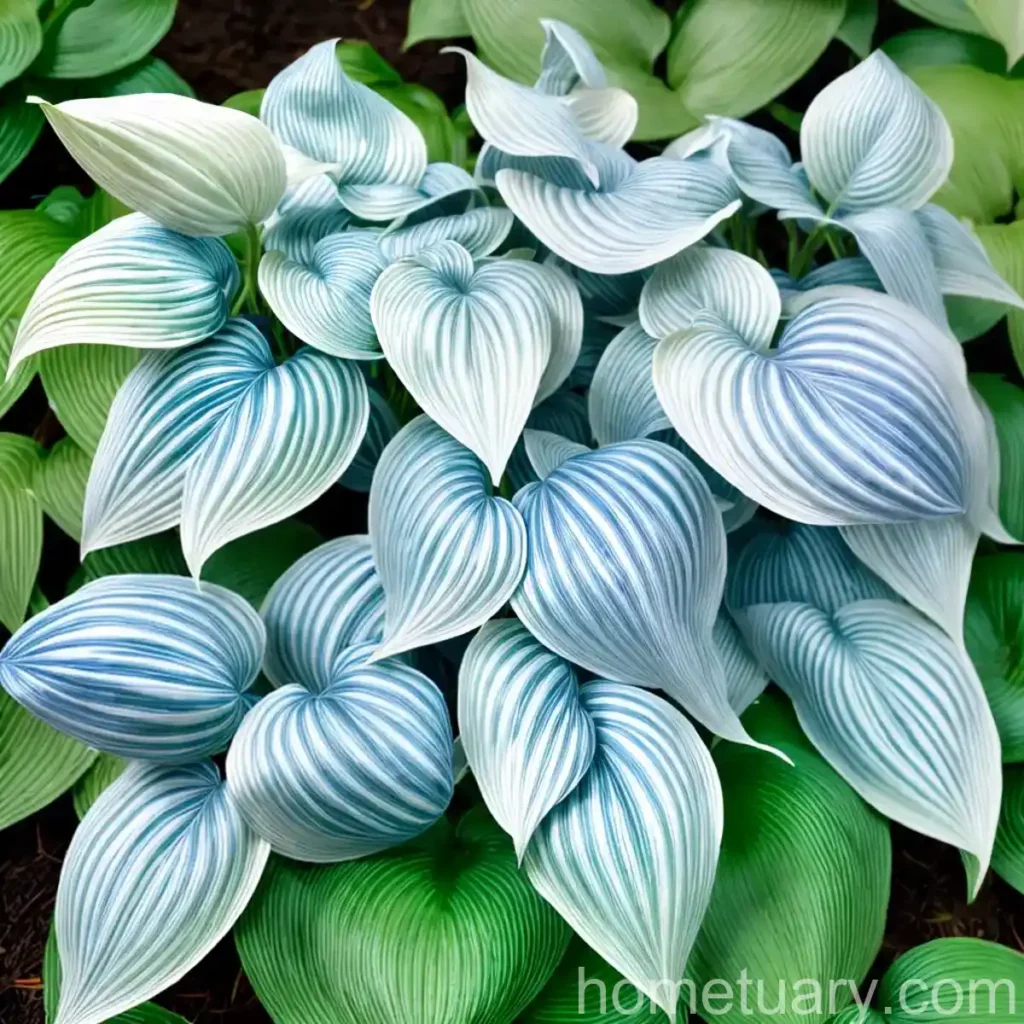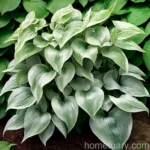Hosta ‘Blue Mouse Ears’: A Charming Addition to Any Garden
Hosta, a genus of perennial plants commonly known as hostas, is a popular choice for gardeners due to their attractive foliage, easy maintenance, and adaptability to various conditions. Among the numerous hosta varieties, Hosta ‘Blue Mouse Ears,’ with its compact size and captivating blue-green leaves, stands out as a favorite for many garden enthusiasts. In this comprehensive guide, we will delve into the world of Hosta ‘Blue Mouse Ears,’ exploring its characteristics, optimal growing conditions, maintenance requirements, and much more.
What is Hosta ‘Blue Mouse Ears’?
Hosta ‘Blue Mouse Ears’ is a miniature hosta cultivar that is cherished for its diminutive size and distinctive foliage. This cultivar features heart-shaped leaves with a unique blue-green coloration, creating an alluring visual impact in any garden setting. Its compact nature makes it an excellent choice for small gardens, borders, and containers.
Key Takeaways – Hosta ‘Blue Mouse Ears’
Before we delve into the specifics of cultivating Hosta ‘Blue Mouse Ears,’ let’s highlight some key takeaways about this delightful plant:
- Characteristics: Hosta ‘Blue Mouse Ears’ is a miniature hosta with heart-shaped, blue-green leaves, and a compact growth habit.
- Size: The mature size of Hosta ‘Blue Mouse Ears’ is typically around 6 inches tall and 14 inches wide, making it an ideal choice for small spaces.
- Shade Tolerance: This cultivar thrives in partial to full shade, making it an excellent option for shady areas in the garden.
- Soil Requirements: Well-draining, rich soil with ample organic matter content is essential for the optimal growth of Hosta ‘Blue Mouse Ears.’
- Maintenance: Low maintenance and relatively pest-resistant, this hosta variety is perfect for gardeners seeking a fuss-free addition to their landscape.
- Propagation: Hosta ‘Blue Mouse Ears’ can be propagated through division, allowing gardeners to expand their hosta collection with ease.
Now that we have established an overview of Hosta ‘Blue Mouse Ears,’ let’s delve into the specific aspects of cultivating and caring for this charming hosta cultivar.
Culture
Cultivating Hosta ‘Blue Mouse Ears’ involves providing the ideal growing conditions to ensure its health and vitality. Let’s explore the cultural requirements for this beloved hosta variety.
Uses
Hosta ‘Blue Mouse Ears’ can be utilized in various ways to enhance the visual appeal of a garden or landscape. Some common uses include:
- Borders: The compact size and attractive foliage of Hosta ‘Blue Mouse Ears’ make it an ideal choice for edging along garden borders, walkways, or paths.
- Containers: Due to its diminutive nature, this hosta cultivar thrives in containers, adding a touch of elegance to patio areas, balconies, or small outdoor spaces.
- Ground Cover: When planted in groups, Hosta ‘Blue Mouse Ears’ can create a lush, low-growing ground cover, filling in bare spots with its captivating foliage.
- Shade Gardens: Given its shade tolerance, this hosta variety is a perfect addition to shaded or woodland gardens, where it can thrive in the cool, dappled light.
Water
Consistent moisture is essential for the growth and well-being of Hosta ‘Blue Mouse Ears.’ Adequate watering, especially during dry periods, is crucial to support the lush foliage and overall health of the plant. However, it is important to avoid waterlogged conditions, which can lead to root rot and other issues. A layer of mulch around the base of the plant can help to retain soil moisture and regulate the temperature, benefiting the hosta’s water requirements.
Sunlight
As a shade-loving plant, Hosta ‘Blue Mouse Ears’ thrives in partial to full shade conditions. When grown in areas with excessive sunlight, the delicate leaves may become scorched or wilted. Therefore, it is best to provide this hosta cultivar with dappled or filtered shade, especially during the intense afternoon sun. In regions with hot climates, morning sunlight or gentle, indirect light is preferable for maintaining the plant’s vigor and foliage quality.
Fertilizer
Fertilizing Hosta ‘Blue Mouse Ears’ is essential for promoting healthy growth and vibrant foliage. A balanced, slow-release fertilizer applied in early spring provides the necessary nutrients for the plant’s development. Additionally, a light application of fertilizer in midsummer can further support the hosta’s nutritional needs. Organic compost or well-decomposed manure can also be incorporated into the soil around the plant to enrich its growing environment.
Soil
The soil composition plays a crucial role in the overall well-being of Hosta ‘Blue Mouse Ears.’ This hosta variety thrives in well-draining, fertile soil with a high organic matter content. A slightly acidic to neutral pH range of 6.0 to 7.5 is ideal for optimal growth. Amending the soil with organic matter such as compost, leaf mold, or well-rotted manure helps improve its structure, moisture retention, and nutrient availability, creating an ideal growing environment for Hosta ‘Blue Mouse Ears.’
Pruning
Pruning hostas, including Hosta ‘Blue Mouse Ears,’ is primarily focused on the removal of spent foliage, blooms, and any damaged or discolored leaves. Regularly removing dead or yellowing leaves promotes the overall health and appearance of the plant. Additionally, trimming back the flower stalks once the blooms have faded encourages the hosta to redirect its energy into foliage growth, enhancing its visual appeal. When pruning hostas, it’s crucial to utilize clean, sharp tools to minimize the risk of disease transmission and ensure precision in the cutting process.
Propagation
Propagating Hosta ‘Blue Mouse Ears’ is a rewarding endeavor that allows gardeners to expand their hosta collection and share the beauty of this cultivar with others. While hostas can be propagated through various methods such as seed sowing and tissue culture, division is the most common and effective technique for increasing the population of Hosta ‘Blue Mouse Ears.’ The division process involves carefully separating the plant into smaller sections, each with viable roots and foliage, before transplanting them to new locations. Dividing mature hostas every few years also revitalizes the plants, promoting vigorous growth and rejuvenation.
Container Popularity
The compact size, exquisite foliage, and adaptability of Hosta ‘Blue Mouse Ears’ make it a popular choice for container gardening. Whether grown in individual pots or combined with other shade-loving companions, this hosta variety adds an elegant touch to outdoor spaces, patios, and balconies. When selecting containers for Hosta ‘Blue Mouse Ears,’ opt for well-draining pots with adequate drainage holes to prevent waterlogging. Regular watering and occasional fertilization support the health and vitality of hostas grown in containers, allowing them to thrive in a confined yet favorable environment.
Common Diseases
While Hosta ‘Blue Mouse Ears’ is relatively resilient, it may be susceptible to certain diseases that can impact its vigor and appearance. Understanding the common diseases affecting hostas is crucial for proactive management and preservation of plant health. Some prevalent hosta diseases include:
- Fungal Leaf Spot: Caused by various fungi, leaf spot diseases manifest as dark, water-soaked spots on the foliage, leading to leaf discoloration and deterioration. Proper sanitation, adequate air circulation, and fungicidal treatments can help manage and prevent fungal leaf spot diseases in hostas.
- Crown Rot: Excessive moisture, poor drainage, or soil-borne pathogens can contribute to crown rot, characterized by the decay of the plant’s crown and root system. Well-draining soil and vigilant monitoring of watering practices are essential for preventing crown rot in hostas.
- Slug Damage: Slugs are notorious pests that can cause significant damage to hosta foliage by feeding on the tender leaves, resulting in unsightly holes and blemishes. Implementing slug control measures such as physical barriers, natural predators, or organic deterrents helps protect hostas from slug damage.
Disease Diagnosis
Timely identification and diagnosis of diseases are pivotal in implementing targeted management strategies to safeguard the health of Hosta ‘Blue Mouse Ears.’ Observing the characteristic symptoms, such as leaf discoloration, lesions, or irregular patterns, aids in identifying the specific disease affecting the plant. It is advisable to consult with local horticultural experts or extension services to accurately diagnose and address any potential diseases impacting hostas in your region, ensuring effective treatment and preventive measures.
Common Pests
In addition to diseases, hostas may also face challenges from various pests that can compromise their growth and aesthetic appeal. Managing common hosta pests is essential for preserving the vitality of Hosta ‘Blue Mouse Ears’ and ensuring its flourishing presence in the garden. Some prevalent pests that may affect hostas include:
- Slugs and Snails: These soft-bodied pests are notorious for feeding on hosta foliage, leaving behind unsightly trails and causing significant damage to the leaves. Employing physical barriers, natural predators, or iron-based slug baits can help control slug and snail populations in hosta beds.
- Deer: In areas with deer populations, hostas, including Hosta ‘Blue Mouse Ears,’ are at risk of browsing damage from these herbivorous animals. Implementing deer-resistant measures such as fencing, repellents, or selecting deer-resistant plant companions can mitigate the impact of deer on hostas in the landscape.
Botanist’s Tips
As a plant scientist with a profound appreciation for hostas, including the enchanting Hosta ‘Blue Mouse Ears,’ I would like to share some valuable tips to enhance the cultivation and enjoyment of this remarkable plant:
- Mulching Benefits: Applying a layer of organic mulch around Hosta ‘Blue Mouse Ears’ not only conserves soil moisture and suppresses weed growth but also moderates soil temperature fluctuations, providing a conducive environment for the hosta’s root system.
- Companion Planting: Pairing Hosta ‘Blue Mouse Ears’ with companion plants that share its shade tolerance and aesthetic appeal creates harmonious garden compositions. Consider integrating ferns, Heuchera, or other shade-loving perennials to complement the beauty of this miniature hosta.
- Disease Resistance: Selecting hosta cultivars known for their disease resistance, including Hosta ‘Blue Mouse Ears,’ can contribute to a healthier and more resilient garden. Research disease-resistant varieties and incorporate them into your landscape for added protection against common hosta ailments.
Fun Facts
To further appreciate the allure of Hosta ‘Blue Mouse Ears’ and hostas in general, here are some intriguing fun facts about these beloved plants:
- Historical Significance: Hostas have a rich cultural history, with origins in East Asia where they have been cultivated for centuries. They were initially prized for their edible shoots in Japanese cuisine before their ornamental value was fully recognized.
- Botanical Diversity: The genus Hosta encompasses a diverse array of cultivars, ranging from miniature varieties like Hosta ‘Blue Mouse Ears’ to large specimens with striking variegated foliage, showcasing the versatility and adaptability of hostas in horticulture.
- Pollinator-Friendly: Hosta ‘Blue Mouse Ears’ and other hosta cultivars produce elegant flower stalks with beautiful, fragrant blooms, attracting pollinators such as bees and hummingbirds to the garden, contributing to biodiversity and ecosystem health.
Links to External Resources
For further exploration of Hosta ‘Blue Mouse Ears’ and valuable insights on cultivating hostas, I recommend consulting the following reputable resources:
- The American Hosta Society: The official website of The American Hosta Society provides a wealth of information on hosta cultivation, hosta varieties, and upcoming events and initiatives related to hostas.
- University Extension Services: Local university extension services offer region-specific guidance on growing hostas and can provide valuable insights into disease, pest management, and best practices for hosta enthusiasts.
- Royal Horticultural Society: The Royal Horticultural Society’s website offers comprehensive guides on hosta care, propagation techniques, and recommended hosta varieties, serving as a valuable resource for gardeners seeking expert advice.
In conclusion, cultivating Hosta ‘Blue Mouse Ears’ offers a delightful opportunity to adorn gardens with its charming foliage and contribute to the diverse tapestry of shade-loving plants. By understanding its cultural preferences, maintenance needs, and ways to preserve its health, gardeners can foster the flourishing presence of Hosta ‘Blue Mouse Ears’ in their outdoor sanctuaries, creating enchanting, tranquil spaces for all to enjoy.
Keywords: Hosta ‘Blue Mouse Ears’ care, Hosta ‘Blue Mouse Ears’ characteristics, Growing Hosta ‘Blue Mouse Ears’, Hosta ‘Blue Mouse Ears’ varieties, Hosta ‘Blue Mouse Ears’ size, Hosta ‘Blue Mouse Ears’ shade tolerance, Hosta ‘Blue Mouse Ears’ soil requirements, Hosta ‘Blue Mouse Ears’ planting tips, Hosta ‘Blue Mouse Ears’ maintenance, Hosta ‘Blue Mouse Ears’ propagation, Hosta ‘Blue Mouse Ears’ division technique, Hosta ‘Blue Mouse Ears’ pest control, Hosta ‘Blue Mouse Ears’ companion plants, Hosta ‘Blue Mouse Ears’ container gardening, Shade-loving Hosta ‘Blue Mouse Ears’, Hosta ‘Blue Mouse Ears’ landscape design, Hosta ‘Blue Mouse Ears’ focal point plant, Hosta ‘Blue Mouse Ears’ garden ideas, Hosta ‘Blue Mouse Ears’ border plant, Hosta ‘Blue Mouse Ears’ ground cover, Hosta ‘Blue Mouse Ears’ perennial, Hosta ‘Blue Mouse Ears’ foliage color, Hosta ‘Blue Mouse Ears’ leaf texture, Hosta ‘Blue Mouse Ears’ leaf size, Hosta ‘Blue Mouse Ears’ dwarf variety, Hosta ‘Blue Mouse Ears’ compact size, Hosta ‘Blue Mouse Ears’ low-maintenance plant, Hosta ‘Blue Mouse Ears’ deer-resistant, Hosta ‘Blue Mouse Ears’ rabbit-resistant, Hosta ‘Blue Mouse Ears’ slug-resistant, Hosta ‘Blue Mouse Ears’ drought-tolerant, Hosta ‘Blue Mouse Ears’ winter care, Hosta ‘Blue Mouse Ears’ spring bloom, Hosta ‘Blue Mouse Ears’ summer growth, Hosta ‘Blue Mouse Ears’ fall foliage, Hosta ‘Blue Mouse Ears’ plant division, Hosta ‘Blue Mouse Ears’ root system, Hosta ‘Blue Mouse Ears’ flower stalks, Hosta ‘Blue Mouse Ears’ pollinator-friendly, Hosta ‘Blue Mouse Ears’ native habitat, Hosta ‘Blue Mouse Ears’ naturalizing, Hosta ‘Blue Mouse Ears’ water requirements, Hosta ‘Blue Mouse Ears’ fertilizer needs, Hosta ‘Blue Mouse Ears’ mulching benefits, Hosta ‘Blue Mouse Ears’ disease resistance, Hosta ‘Blue Mouse Ears’ leaf fragility, Hosta ‘Blue Mouse Ears’ sun exposure, Hosta ‘Blue Mouse Ears’ garden borders, Hosta ‘Blue Mouse Ears’ edging plant, Hosta ‘Blue Mouse Ears’ container plant















